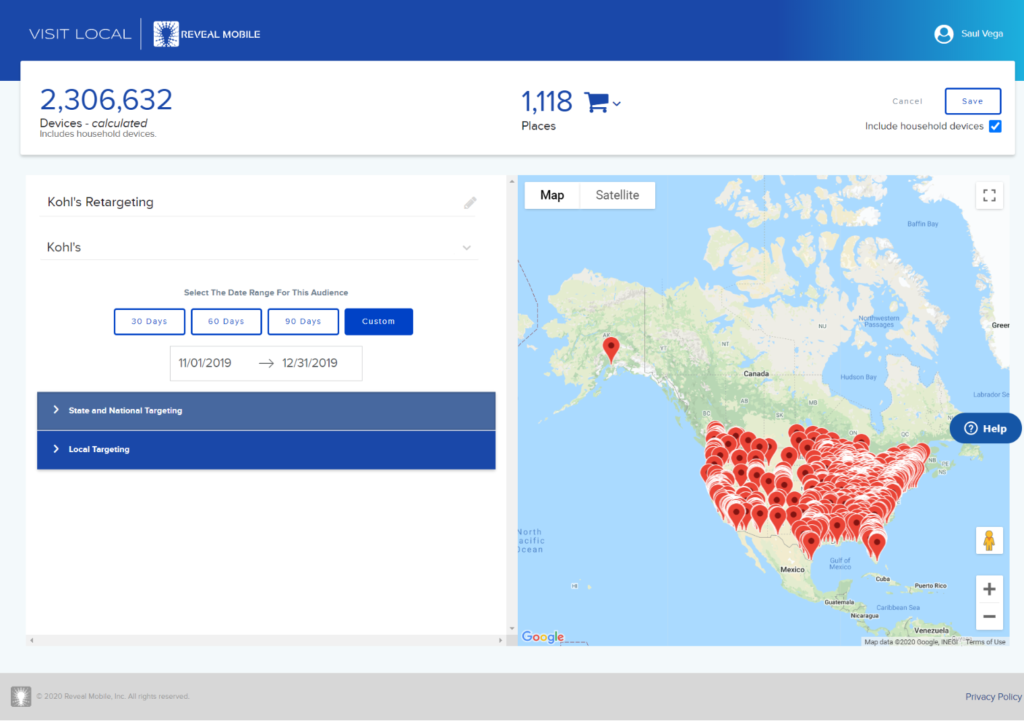Geofencing Marketing for the Holidays
November 6, 2020 by
How to move your in-store shoppers online for holiday shopping
U.S. retail sales for the holiday season will reach $1.013 trillion, up 0.9 percent from last year, but brick-and-mortar retail sales are expected to drop 4.7 percent. While more than 80 percent of shoppers will do most of their holiday shopping online this year, fully two-thirds of all consumers say it’s important to support local retailers.
With most retailers transitioning to e-commerce to meet customers’ needs, how can you make sure all of your or your clients’ potential customers know about your online store and shop there?
This post walks you through several geofencing marketing ideas you can use right now to move your in-store audiences online. Many consumers started their holiday shopping early, so there is no time like the present to kick off these campaigns. It takes just minutes to build these audiences, which are ready for immediate import into social media platforms, or wherever you run ads. They can also be used in conjunction with the campaigns you are already running. Digital campaigns are quick to employ and compelling CTAs for the right audience will drive traffic right away.
Retarget Last Year’s In-Store Shoppers
Marketers are familiar with retargeting people who visit their websites. When marketers run location-based marketing campaigns, their first instinct is to retarget their own customers based on store visits. But did you know you can look back all the way to the 2019 holidays to retarget those in-store shoppers as a cohort? To target people you know were in your stores shopping last year during the prime holiday shopping months, you can create an audience of visitors between October and December 2019.
One of the biggest destinations for holiday shopping is Kohls. Here’s a look at their in-store visitors between November and December 2019. That’s 2.3 million people to target and offer this year’s e-commerce holiday specials.

Convert Your Loyal In-Store Shoppers to eCommerce Customers
Another idea is to build an audience of customers who have been shopping with you all year long. These are loyal customers helping keep your or your clients’ doors open. Reward them for their loyalty by offering them a percentage off. Or if they spend above a certain threshold — say $100 — they get $20 to use in-store or online for a future purchase.

With the right geofencing marketing tool, you can easily see and target frequent visitors to your or your client’s locations.
Home improvement stores, such as Ace Hardware, are a destination for gifts for dad. Think power tools and shop organization. You can build an audience of visitors to these types of locations throughout the year, add household devices to include the partner or spouse who would be buying the gift, and serve them all ads featuring that shiny new power tool. You can speak directly to the shoppers to trigger a wishlist and encourage them to talk to their loved ones as to where to get them their perfect gift online. Here’s what building that audience looks like.
Win market share from competitors
75% of U.S. consumers have shopped a new brand during the pandemic. When evaluating new brands, consumers are looking for three things: value; availability; and convenience. This opens up opportunities to win new customers. The best way to do it is through geoconquesting and the right kind of offer.
Imagine you are marketing furniture. You can geofence IKEA and capture visitors to their locations to entice them with your offer. You can also include household devices in your audience since furniture is typically a decision made by both adults in the home.

Since consumers are evaluating brands based on value, availability and convenience, another idea is to geotarget customers of brands that may be lacking in one of those categories. Old Navy, a clothing brand known for affordable prices and big sales, could geotarget shoppers to American Eagle, a competitive clothing brand whose prices are higher than Old Navy’s. Here’s a look at last year’s American Eagle’s holiday shoppers in Chicago. (Can you hear us, Old Navy?)

What If I Sell Exclusively Online?
If you do not have physical stores, there are still ways to grow your online business for the holidays. Marketers can target shoppers who go to stores that sell similar products. For example, Wayfair can target Homegoods, Pottery Barn and Macy’s Furniture shoppers. Rothy’s and accessories can target accessory lovers who shop at Nordstrom, Neiman Marcus and Sperry’s.
To get access to your ideal audience and move your in-store customers online, contact us today.

